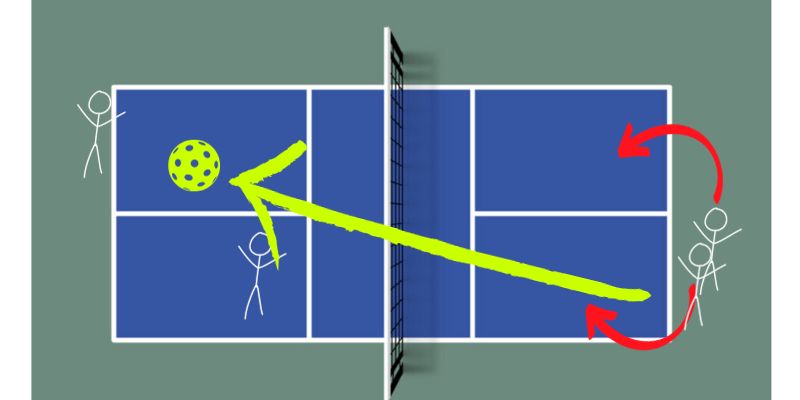Are you curious about the mysterious technique of stacking in pickleball? You’re in the right place! By the end of this journey, you’ll understand the intricacies of this strategy, its advantages, and even how to turn it to your advantage when confronted with it.
Table of Contents
- Starting Position Dynamics
- Normal Play vs. Stacking
- Execution of Stacking
- The Why Behind Stacking
- Exploiting Stacked Opponents
- Strategies for Both Teams
Understanding the Starting Position
The foundation of pickleball positioning lies in the starting position. It’s not just about being on one side or the other. It’s a strategic orientation based on even or odd scoring. When the score is even, players have designated sides, ensuring consistency and setting a familiar footing for each point. This simple yet pivotal strategy can shape the entire flow of the game.
Key Insights:
- Strategic Anchoring: Starting positions as a strategic anchor for consistency.
- Predictability and Adaptation: Leveraging the familiarity of positions for better adaptability during gameplay.

Normal Play vs. Stacking
The conventional norm in pickleball involves side switches after each point, a routine most players are familiar with. However, the game takes an intriguing turn with stacking, an alternative strategy that challenges the usual rotational pattern. Stacking introduces a whole new dimension, allowing players to maintain their preferred sides consistently throughout the game.
Learn More Pickleball Strategies
Key Insights:
- Strategic Departure: Stacking as a departure from the standard side-switching norm.
- Consistency and Advantage: Leveraging stacking for strategic positional advantage throughout the match.
Execution of Stacking
Visualizing the execution of stacking reveals a critical shift in gameplay dynamics. Instead of the customary side switch after winning a point while serving, stacking involves a tactical repositioning of players to maintain a constant strategic advantage. This bold maneuver disrupts the expected flow, creating a constant positional advantage for the team employing it.
Visualizing Stacking:
- Strategic Setup: Stacking isn’t just about maintaining preferred sides; it’s a deliberate setup aiming for a consistent advantage. When the serving team wins a point, instead of the customary side switch, they maintain their positions. For instance, if one player is stronger on the left, they persist on the left side even after winning the point.
Positional Maneuvers:
- Strategic Repositioning: After serving and winning a point, players involved in stacking can strategically maintain their positions. This involves one player staying on their preferred side while the other moves to their preferred side, creating a two-player presence on one side.
Continuous Advantage:
- Persisting Preferred Sides: Stacking ensures that players remain on their strengths. This constant positioning offers an edge, allowing players to consistently capitalize on their skills, cover weaknesses, and maintain their strategic advantage without the usual side switching.
Tactical Realignments:
- Adaptability in Strategy: Stacking is not a fixed tactic but can dynamically adjust during the game. For instance, after a side out, players can easily revert to their starting positions, adapt to new game scenarios, and maintain a strategic edge with minimal disruption.
Communicative Measures:
- Team Coordination: Effective communication is vital for seamless execution. Players signal each other to ensure they maintain their desired positions, whether it’s an after-return switch or maintaining their original setup.
Strategic Implications:
- Tactical Disruption: Stacking disrupts the expected gameplay dynamics, forcing opponents to adapt to a different strategic play. It’s not just about maintaining sides but leveraging player strengths and weaknesses for a sustained advantage.
The execution of stacking involves deliberate and strategic positioning to maintain a consistent advantage. It’s not just about sticking to preferred sides but adapting and realigning based on the gameplay dynamics to maximize tactical advantages.
The Why Behind Stacking
Understanding the motivations behind employing stacking helps in appreciating its potential benefits. Stacking isn’t just a random move but a strategic maneuver rooted in specific player strengths, covering weaknesses, maximizing power, and creating a distinctive look on the court. It’s about capitalizing on player attributes to craft a stronger gameplay advantage.
Key Insights:
- Strategic Maximization: Leveraging player strengths and minimizing weaknesses for a competitive edge.
- Unique Court Dynamics: Utilizing stacking for a unique look and potential tactical advantage.
Exploiting Stacked Opponents
Unwinding the stack can be a tactical move to exploit opponents’ transitional vulnerabilities. It involves capitalizing on their movement, targeting players in transition—especially on their weaker sides—to seize the advantage. It’s about understanding and countering the strategic positioning employed by opponents to gain an upper hand.
Key Insights:
- Strategic Exploitation: Capitalizing on opponents’ transitional movements for tactical advantage.
- Strategic Counterplay: Leveraging knowledge of opponents’ movement for counter-strategies.
Strategies for Both Serving and Receiving Teams
Whether serving or returning, distinct strategies can be adopted to leverage stacking. For the serving team, unwinding the stack by targeting players in transition becomes a strategic approach. As the return team, the emphasis is on returning deep down the line, causing movement and exploiting opponents’ weaker sides.
Key Insights:
- Strategic Serve Tactics: Targeting players in transition for a strategic advantage.
- Strategic Return Tactics: Leveraging depth and directional returns for positional advantage.
The concept of stacking in pickleball isn’t just a matter of positional shifts but a strategic maneuver with numerous implications. Leveraging it requires understanding both the advantages it offers and the ways to counter it.
So, if you’ve found this information intriguing, dive deeper into the world of pickleball strategies. And if you’re intrigued by tactical moves and want to explore further, check out our other videos. Let the game of pickleball enthrall and challenge you in the most intriguing ways!



